|
Eels, ID 2/9/19
Hi,
<Hi Charlie>
I was wondering if you can help me ID an eel in Indonesia?
<Ahh yes...it appears to be a Harlequin snake eel (Myrichthys colubrinus). >
Thanks, Charlie
<You’re welcome. Wil.>
|
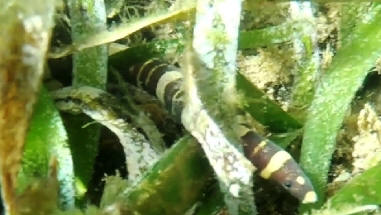 |
|
Snake Eel boo boo? 10/21/15
HI!
<Car>
Here's the story. So I noticed about 2 months ago, that along the top of my
Banded Snake Eel there were spots on the dorsal fin that were gone and there
were sores. I separated him into a 40 gallon tank by himself and they healed.
The only critter I thought did this was the Harlequin Tusk……. So I sold him,
which he is the only one I would have thought to have done this since I have
never seen this before, but I never had a harlequin in the same tank as a snake
eel. Besides that I woke up to an obliterated large Solar Fairy Wrasse, and the
Tusk looked quite full….. that was the other reason….. besides my Lubbock hid
WAAAAYYYY to <too> much after I added the Tusk.
After the Banded Snake Eel healed, I put him back in the main display….. and it
happened again about a month later (when I noticed). I know something was wrong
when he is not swimming around every 2 or 3 days (when he is hungry).
I didn’t have a rose bubble tip anemone at the time, but I do now, however I do
not suspect it. I DO suspect my Frogspawn which has caused ME lesions/sores on
my skin! Here is my list…. everyone gets along fine, and besides the
Frogspawn I do not know what to expect.
<Something has stung this fish>
Water parameters all good and normal…. 500 calcium,
<Much too high.... see WWM Re... sigh>
pH 8.2, alk 6-8, Mag 1300, 0 ammonia, 0 nitrite, 10 nitrate, blah blah blah. I
did wonder if maybe it was the live rock, but I have NEVER seen this issue with
the spotted snake eel or a different banded snake eel that I had 10 years ago.
<Have seen this over an over... from water quality, nutrition, social.... other
environmental causes>
Fish:
Baby Purple Tang
Young Copper Banded Butterflyfish (have had for 9 months… big fatty)
Solandri Puffer (this guy was in the 40 gallon tank when the snake eel was
healing last time)
Pair of Pink Skunks
Pair of Perculas
Yellow Tailed Damsel (chill personality species no aggression ever seen)
Lubbocki Fairy Wrasse
Cleaner Wrasse (I have had him for well over 1 year)
Royal Gramma
Engineer Goby (was in the tank with him when he healed too)
CORALS (mostly frags):
Frogspawn
Rose Bubble Tip
<The bigger stingers here>
GSP
Palythoas large colony… generic coloring that was also in the tank when he was
healing
Duncan
Purple Mush,
Trumpet Branching coral
Digitata
Sympodium
Kenya
Favia
My suspect is the Frogspawn, but I wonder if you would concur. I have only see
the Copperbanded “pose” angry when the Snake Eel came out, but never struck him
that I saw. The wound is suspiciously about the same size as the frogspawn…… AS
I TOOK the eel out, what was left behind was white stringy slimy stuff…. I am
guessing he was wrapping himself up to heel? He does NOT like to go under the
sand…. never did from the time I got him…. maybe once or twice, but he is a
large adult so I wonder if the babies are more likely……. So the sand is only
sand…. no crushed coral, etc.
I put in Metroplex, but wonder if I should do Kanaplex instead….. that stuff is
potent!
<... in the main, display system? A mistake.... see, as in actually READ on WWM
Re. We can't help you if you won't read. Bob Fenner; sighing still>
|
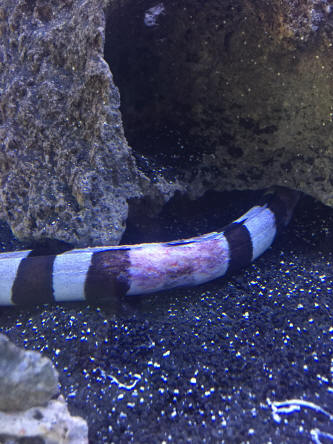 |
|
Re: Snake Eel boo boo? 10/21/15
Hello,
<Ms. C>
First, the calcium I know is on the high side, yet I am working to lower it. I
had this happen when I started using TropMarin at $99 for a 5 gallon bucket.
<Wow; a bargain!>
I have NEVER ADDED any calcium or magnesium to make it this high, so please do
not assume I just put in up there on purpose. Jumping to conclusions
that I don’t know that 450 is the high end are we?
>See WWM re... I'd keep below 400, Mg in proportion<
**SIGH**… should stick with cheap salt?
<....? See WWM re this also>
I only put this there to see if it was a possible reason for the sores, not for
you to judge me. 500 is NOT too high by the way.
<Am not judging you; simply stating fact>
Read a few more website articles and books and you will see that it is not an
issue UNLESS the pH ends up depressed!!! SIGH that you don’t acknowledge that in
your reply.
<.... Google my name>
Second NO, I DID not put the MetroPlex in the main display. (((SIGH))) Like I am
that stupid! I put him BACK into the 40 gallon tank with cured rock.
Also, I KNOW THE WORD IS too and not to…. I have a migraine, sorry. I am sure
you NEVER make typos.
<Heeee! No worries>
Out of the brief list of what you suspect:
Water Quality: Do you THINK 500 calcium is what did it,
<Not likely, no>
if you did, then you should say something or OFFER help, not “sigh” and “you
need to read” blah blah…. I do read… I read a lot and this is a NEW ONE TO ME
and my pH is fine, so I didn’t think it was an issue and I KNEW there would be
some comment about it! So maybe offer help instead of putting people down?
Nutrition: He only likes shrimp but i do add Selcon into it. REMEMBER he HEALED
in a separate tank, so how could it be nutrition???
<Can't say w/o more data>
Social: You didn’t give ANY indication out of the list I gave to you WHICH fish
would maybe be the culprit.
<See prev. corr..... the anemone or...>
My thought is that you have SAID you have seen this often. So WHY haven’t you
written a paper or posted something on your website showing pictures of the
wounds? NO? **SIGH** I have read through your website… I have NEVER SEEN a
picture of this, I have never seen any suggestions on how to fix or cure this.
NONE of my snake eels in the past EVER had this. My tanks are all about the
same. I will be looking elsewhere for CONSTRUCTIVE conversation and problem
solving.
<Chill pill dear. And we'll be chatting, Bob Fenner>
|
|
Update on Squigglesworth, the Key Worm Eel
3/2/13
Hey all,
<Hi.>
Thank you so much for everything you do :) now on to the subject. On the
first of this year, I received a free eel that you all tried to help ID.
Well, after figuring out it is a Key Worm Eel, I figured I would share my
observations so if anyone else acquires one, they can at least have a little
reference. Mr. Squigglesworth, as he has been named, now has some friends. I
found yet another Key Worm Eel, as yet unnamed. After a little squabbling,
they have settled down and now if one is out, the other soon follows. Mr. S,
the original eel, loves sinking pellets and has taught the other one to eat.
They bury themselves for most of the day and let us know when it is dinner
time when they start searching their floor. They are currently living with
many Blue Leg Hermits, two Green Emerald Crabs, a Blue Green Chromis, and a
Pulsing Xenia. Of all these critters, the 2 eels completely ignore them.
When they are out, the Chromis tries to school with them and the eels ignore
the fish. On the food front, because Mr. S is so fast and shy, I had to just
drop in chopped up foods until something worked. As I said, turns out he
liked the algae pellets I was dropping in for the crabs. Now that I know
he's willing to eat these, I have since purchased carnivore pellets of 2mm
size for him and his new friend. Again, these are just my observations and
in no way reflect the best possible scenario for these two. However, I
couldn't find any information on these two so had to figure it out,
including bugging you guys (Marco) for knowledge. In the near future, these
two will be moving to a 55 gallon home as I think they might be happier with
a bigger sand bed to tunnel through.
As I have always loved benthic critters and burrowing fishes, all my rock
work is firmly on the glass bottom. So, without further ado, here is two
nice blurry photos of two Key Worm Eels that never stop moving long enough
for my camera or hide their faces otherwise :)
<Thank you very much for the update. It sure will help future readers, who
get themselves one or more key worm eels. Thanks also for the pics. I hope
you continue having fun with your unusual pets. Cheers, Marco.>
|
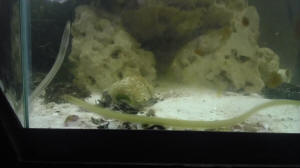
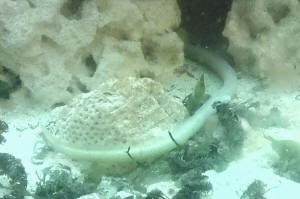
Re: Key worm eel - better pictures! Now comp./stkg.
3/18/13
Okay guys and gals, as always, thank you so much for your help and your
website! Here's the next set of questions. ;) Mr. Squigglesworth and his
girlfriend (the Key Worm Eels) have a Magnificent Firefish, a Blue-Green
Chromis, and a Pygmy (Cherub) Angelfish all living peacefully together in a
35 gallon hex tank. We have decided that in the next few
months, the eels will be moved to a 55 gallon tank to have more
floor space.
<Sounds good.>
However, I would like to get a sand sifting goby for the 35 hex now that I
can detect growth in the sand. The goby would be living with the eels
temporarily until they move. I am partial to the Yellow Watchman Goby
because of size, behavior, and looks but would like some suggestions.
<A lot to choose from. Start here:
http://www.wetwebmedia.com/gobies.htm >
Also, eventually, I would love a Pygmy Hawkfish and a Cinnamon Clownfish.
So, in the end; 35 gallon hex with: Magnificent Firefish, Blue-Green
Chromis, Pygmy Angel, Pygmy Hawkfish, Cinnamon Clown, and a goby.
<The clown would do best with a partner and maybe an anemone if you have
proper light and filtration. See
http://www.wetwebmedia.com/marine/inverts/cnidaria/anthozoa/anemones.htm
and
http://www.wetwebmedia.com/clnfishart2.htm >
After the 35 is set, I'll also have the 55 set up that I'll need to stock so
some of these guys can go in there instead, if it would be better. Just in
case you were wondering, I admit my 'fishy' addiction. ;) but only if they
can be completely spoiled rotten. ;)
<The 35 is already full in my opinion and I'd only add the fishes you want
once the eels are removed. Also, I'd plan to take at least the Cherub angel
to the larger tank.>
As always, you all are my go-to resource for knowledge, even if I can't
really have all the fishies :) Sandra in Florida, USA
<Thanks for your kind words! Cheers, Marco.>
|
the Banded or Harlequin Snake Eel. Beh. 3/31/11
Hello,
Just a quick question. I have one Banded Snake Eel
<Mmm, not easily kept; you're to be commended>
in my saltwater 250 gallon tank, from very first day it stays under
gravel and comes out at night after three four days.
Is there any way we can encourage him/her to stay out during day
time.
<If you can keep it alive for weeks/months, it will begin to stay
out more>
Regards
Abdul
<And you, Bob Fenner>
|
Zoanthid ID & juvenile angel & eel ID
3/8/2010
Hey Crew !!!
<Hey Abdo!>
Abdo here, from the land of the pharaohs :D (AKA aquarium no
man's land!!!)
<Ahh, hope to be diving w/ friends in Sharm this coming
May>
First I just want to show my deeeeep gratitude for you guys being
there,
really makes the difference !!! from the bottom of my heart:
THAAAAAAANK YOUUUUUUUU
<Welcome>
now down to business
I have just ventured into invertebrates and I'm having a hard
time identifying that group of polyps I just bought, the tank
they were in at the retailer's was such a biohazard that a
military submarine wouldn't survive !!!
<Heeee!>
anyway I attached a picture, it was taken the day after I put
them in the tank, they were acclimated very slowly over 4 hours
and now I think 80% of them have opened completely :D Yay :D Hope
you guys could help me treat the polyps well :)
<Looks to be some species of Zoanthid; very nice>
Another question, hope I'm not being a pain in the neck
here......
I bought what I identified positively as a vermiculated angel, at
just under an inch long!!!, do you have any special
recommendations regarding such a fish, given its size and other
tank inhabitants ??? any advice ???
<Mmm, yes... keep it with small-ish, easygoing fishes,
non-predatory invertebrates and you should be fine. These angels
grow quite quickly when small, given good circumstances>
lastly (I promise), I had bought those 2 eels a while ago, and
I've been having such a hard time identifying them it drives
me crazy !! their looks are not special but their behavior amazes
me!! They are grey with white bellies, 30cm long with 1cm
diameter or so, small eyes, dotted lateral line near the head and
curved, burrow under the sand and they do it backwards, meaning
they stick their tails in and slip into the sand bed, and once
they grab a piece of food they quickly pull it down under the
sand to eat it, the retailer said they we're from the red
sea, but I wouldn't count on anything he says.
the closest matches I could find in Dr. Burgess's atlas of
marine aquarium fishes were "Pisodonophis cancrivorus"
and "Muraenichthys tasmaniensis" but I'm not so
sure..... I attached the best picture I could take, hope it
helps.
<Mmm, is an Ophichthid... a Snake Eel... looks a bunch like an
Apterichthys species... Unfortunately I don't see this
species in my in-print reference works, and Fishbase.org is
running VERY slowly currently. I would go there, and search
"By Country" (I did for Jordan), Marine fishes (which
will come out by default by species) and re-sort by family...
Look at the Ophichthids found there (the Red Sea)... and try to
find these species for photos, further descriptions>
I have a 110G + 20G sump, since August 2008, sandy bottom with
one pile of LR, some locally obtained Ulva, 2 four stripe
damsels, 1 domino, 1 silver moony, 1 Aidablenius sphynx, many
coastal shrimps, 1 vermiculated angel, 1 common goby, 1 red
tomato, 1 urchin with short sharp spines (red sea), several
mussels and oysters, some Nerites, the 2 eels and the clump of
Zoas.
<Sounds very nice indeed!>
Thank you in advance, and sorry for the long email :S
<Thank you for sharing! Bob Fenner>
|
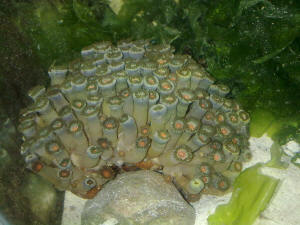 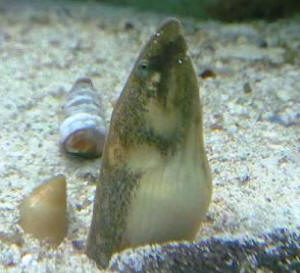 |
Stargazer snake eel
Brachysomophis spp. snake eels -- 01/07/10
Hello.
<Hi.>
I was just wondering if there was any information on captive care of
either a reptilian snake eel, or a stargazer snake eel, or anywhere
that might be able to order one in.
<The latter can be difficult and will also depend on where you are.
Ask at your shops to ask their suppliers and the rare fish traders
online.>
I've been unable to find any information whatsoever.
<Try searching for Brachysomophis henshawi and Brachysomophis
cirrocheilos. They are best kept in single specimen setups. Training to
dead food can be difficult. You should have the possibility to feed it
live food (small fishes (no FW-feeders) and crabs). They also need a
large open surface area with not much live rock. Aside that care should
be easy.>
I assume it is safe to say they are ambush predators?
<Yes, mostly, but will also come out to hunt.>
How deep would the sand bed need to be?
<At least 20 cm / 8 inches, preferably 30 cm / 12 inches.>
Do they hide just under the surface, or burrow down like a garden
eel?
<They hide at an angle to the surface, not as vertical as some
garden eels.>
Thanks for any help.
<Welcome. Marco.>
Spotted/tiger snake eel Hello, <Howdy> I just wanted to
say thank you for your past answers, they have proved helpful when I
have not been able to find an answer on your site. I have a comment
about the opinion of the Ophichthidae family; that no one should own
one. <Mmm, well, not "no one", but folks (as always)
should be informed as to the history, likelihood of their survival,
their husbandry...> I DO AGREE about the ribbon eels, those poor
things are beautiful and due to their environment, shouldn't be
kept. Bravo for those who have managed to keep them alive. Now for my
issue. I was at a LFS and was going to get a couple of engineer gobies
to keep my 2" sand bed stirred. The man there showed me 3 adults
that were returned because of their 12" size where making a sandy
mess of everything. I was disappointed as I really wanted an eel, but
not in a reef/fish/invert (no shrimp) tank. He then showed me a Spotted
Snake Eel, or as some call it a tiger eel. Upon my investigation of the
animal's scientific name (Myrichthys maculosus) light colored with
large brown spots all over including large brown spots on the face
(there is another snake eel that has spots on the face, but they are
tiny dots....not mine). I was sold the snake eel (we will call
"spot") for 39.99, which I come to find was quite a good
deal. He told me to feed spot once or twice a week ghost shrimp. Okay,
I get spot home and watch him swim in and around all my live rock
(found a hole he hangs out in now) and I got to thinking, this little
guy HAS to eat more than that given his activity level. So I put in the
ghost shrimp, and he only finds and eats DEAD ONES because his eye
sight is awful. <... this is a nocturnal animal...> I then bought
some frozen silverbacks to mince and feed my anemone, and thought for
kicks I will offer a whole thawed one to spot. BOY DID HE LOVE IT!!! He
eats right out of my hand (which is not uncommon for the wild ones in
Hawaii or Australia). <Mmm, not found in Hawaii:
Fishbase Summary.> He had 3 large ones one night and then 1 1/2
days later ate 2 small. I know he is hungry when he swims around
bobbing his head up and down. My point is, these particular
Ophichthidae are NOT hard to care for as long as you FEED THEM!!!
<Good point> I read they tend to get starved to death. Cool thing
is, my 3 young ocellaris clowns are quite safe (2" babies) as SPOT
is as blind as a bat and not interested in anything that moves!! So
please, those who have purchased these snake eels, have fun, do your
homework and you will LOVE them as a pet. In my opinion BETTER THAN A
POISONOUS PUFFER FISH!! Take care, and I hope you put this on your
"Snake Eel" page. <Will do, definitely> Those of us who
bought our snake eels (since a real eel is out of the question for
reef) LOVE THEM so much and if we made the mistake of buying them,
should not be made to feel like a bad person. By the way my LFS had a
blue ribbon eel that was eating live mollies (big ones) every other
day........a ribbon eel is NOT, in my opinion good for reef tanks with
little creatures!!) Take Care! Carrie :) <Thank you for sharing this
valuable input. You have likely saved many Myrichthys! Bob Fenner>
Unicolor snake eels Hi, Do you know anything about unicolor
snake eels, (Uropterygius concolor) ? _ http://liveaquaria.com/product/prod_Display.cfm?pCatId=1737_ (
http://liveaquaria.com/product/prod_Display.cfm?pCatId=1737)
They seem like an interesting eel and kind of look like the ribbon
eels. Can I keep these kinds of eels with damsels and clownfish? <If
you read what I read, it says they ambush small fish during the night.
James (Salty Dog)> thanks <You're welcome>
Myrichthys colubrinus and Blue Ribbon Eels My girlfriend
purchased a Banded Snake Eel about two years ago, an amazing creature.
We have found this particular Eel/Snake to be one of the easiest marine
animals to keep in our tank. However I'm reading online that its
not recommended for home aquariums. Is there a particular reason why
the Banded Snake Eel is considered a "Restricted Species" in
many pet stores? <Mainly that most folks experiences are 180 degrees
different than yours... Most Snake Eels, Ophichthyids, die from lack of feeding
in captivity... the remainder generally escape their enclosure through an
opening at the top.> Feeding is extremely easy, and it requires only basic
water/light conditions. I would recommend this snake/eel to anyone; would you?
<I don't. Please see here: http://www.wetwebmedia.com/ophichthidae.htm and the
FAQs beyond> We purchased a Blue Ribbon Eel out of impulse a week ago, and they
are not something I would ever recommend to any aquarium owner. <Me neither...
same reasons> To our surprise the pet store in which we purchased this Eel
understands its difficulty to keep and is allowing us to return it. We have
tried live foods, but all it was interested in was in our "Disappeared" juvenile
Damsel. Quite an expensive meal for a fish that probably wouldn't last another
week in our tank. We didn't do our research and just bought on impulse;
something that saltwater fish tend to do as their vibrant colors and exotic
looks entrap onlookers. <Live and hopefully learn> We are taking the Blue Ribbon
Eel back to the pet store tomorrow. Better to have it die in someone else's tank
then our own, however we would rather it not die at all! We would just like to
personally thank you and your site for helping us with our future purchases as
you classify which species are best for home aquariums. <Thank you for your
input and acknowledgement. Bob Fenner
|
|

